German Hospital
Ritson Road, Dalston, E8 1DF
Medical dates:
Medical character:
Acute. Later, psychiatric and psychogeriatric
A Hospital with a particularly
complicated history, it was founded in 1845 in Dalston Place, on
the south side of Dalston Lane.
It offered free treatment to German-speaking immigrants,
regardless of religion or origin, many of whom
worked and lived in poor conditions in the East End of London, although
it did not discriminate and also cared for English-speakers in
emergencies. In fact, most of its out-patients were the English
poor. The Hospital occupied three houses converted from the
Dalston Infant Orphan Asylum, and had 12 beds.
By 1850 the building of the North London railway track had progressed through the area; the cutting ran behind the Hospital, severing it from its garden. This no doubt stimulated the Governors to build new premises in the garden. The new building opened in 1864, and the Dalston Lane frontage was rented out.
The Hospital now had 100 beds with a front entrance in Alma Road (which was renamed Ritson Road in 1877). Access from Dalston Lane was restored in 1867, when a bridge was built over the railway line.
By 1890 the Hospital had 142 beds.
A Sisters' House was added in 1911. Another block was added in 1912.
During WW1 the German staff remained at the Hospital, despite strong anti-German feelings from the local population.
By 1931 the Hospital had 161 beds. A new 5-storey wing opened in 1936, housing the maternity and children's wards, and a roof garden for convalescents which enabled views right across London. There were then 192 beds.
During WW2 the German staff were arrested in 1940 and interned on the Isle of Man as enemy aliens. English staff took over the running of the Hospital.
In 1948 it joined the NHS as a general hospital, with 217 beds. From 1974, during one of the many NHS reorganisations, it became a psychiatric and psychogeriatric Hospital.
By 1976 it was partially empty and finally closed in 1987, with 95 beds. Its services were transferred to the new Homerton Hospital.
By 1850 the building of the North London railway track had progressed through the area; the cutting ran behind the Hospital, severing it from its garden. This no doubt stimulated the Governors to build new premises in the garden. The new building opened in 1864, and the Dalston Lane frontage was rented out.
The Hospital now had 100 beds with a front entrance in Alma Road (which was renamed Ritson Road in 1877). Access from Dalston Lane was restored in 1867, when a bridge was built over the railway line.
By 1890 the Hospital had 142 beds.
A Sisters' House was added in 1911. Another block was added in 1912.
During WW1 the German staff remained at the Hospital, despite strong anti-German feelings from the local population.
By 1931 the Hospital had 161 beds. A new 5-storey wing opened in 1936, housing the maternity and children's wards, and a roof garden for convalescents which enabled views right across London. There were then 192 beds.
During WW2 the German staff were arrested in 1940 and interned on the Isle of Man as enemy aliens. English staff took over the running of the Hospital.
In 1948 it joined the NHS as a general hospital, with 217 beds. From 1974, during one of the many NHS reorganisations, it became a psychiatric and psychogeriatric Hospital.
By 1976 it was partially empty and finally closed in 1987, with 95 beds. Its services were transferred to the new Homerton Hospital.
Present status (May 2008)
The Grade II listed buildings with their contemporary lodge and eastern extension have survived. The site has now been developed by Landmark Housing as affordable housing for those who earn less than £22,000 a year.
The Grade II listed buildings with their contemporary lodge and eastern extension have survived. The site has now been developed by Landmark Housing as affordable housing for those who earn less than £22,000 a year.
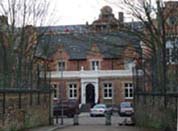
The main entrance to the original 1864 building, approached across a small bridge across the railway from the north
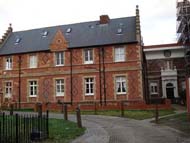
The side elevation of the same building from Ritson Road. The small entry on the right is to a chapel.
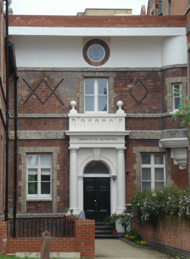
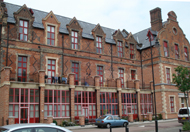
The block built in 1863 (above and right)
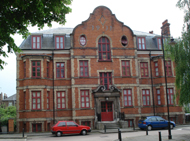
The Sisters' Home, which was built in 1911
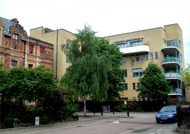
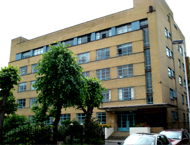
The front elevation of the 1936 block in Fassett Square
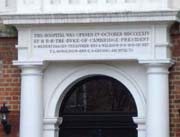
The legend above the doorway stating "This Hospital was opened in October MDCCCLXIV by HRH the Duke of Cambridge President"
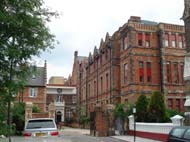
The
view from Ritson Road shows the previous building on the left, the
chapel entry and the large wing which has recently being renovated
(December 2007).
The chapel entrance with the legend 'Christo in aegrotis' ('to Christ in suffering') written above the stuccoed Tuscan doorway.
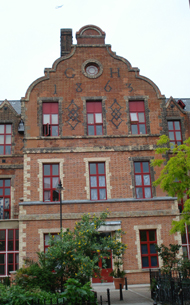
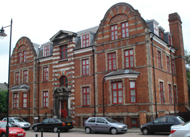
A 1912 block, adjacent to the Sisters' Home, was presumably the Nurses' Home
The
1936 ward block as seen from Brazenose Lane. This building,
designed by the architects Burnet Tait & Lorne, had a famous roof
garden for convalescent patients.
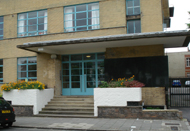
The entrance steps to the 1936 ward block
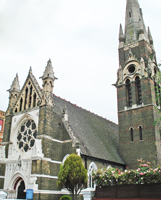
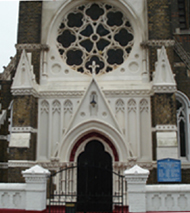
The
church (originally the Hamburg Lutheran Church and now the
Faith Tabernacle Church of God) was built in 1876 and used by both
staff and patients. The minister at the outbreak of WW2 was Revd.
Schonberg, a fervent Nazi, who fled the country in 1939.
Other 'lost hospitals' in Hackney are the Mothers', the Eastern, St. Leonard's and the Hackney, which were all replaced by the Homerton Hospital.
McKeller E 1991 The German Hospital, Hackney. London, Hackney Society Publications
http://hoop.ground-level.org
www.aim25.ac.uk
www.bartsandthelondon.org.uk
www.british-history.ac.uk
www.derelictlondon.com
www.homerton.nhs.uk
Return to home page